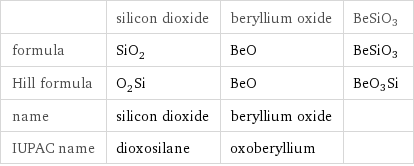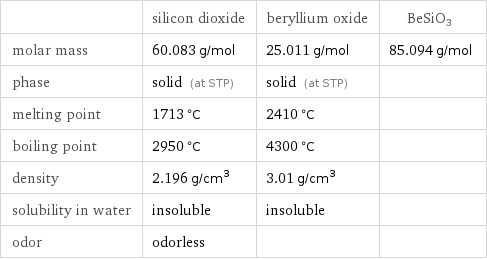Input interpretation

SiO_2 silicon dioxide + BeO beryllium oxide ⟶ BeSiO3
Balanced equation

Balance the chemical equation algebraically: SiO_2 + BeO ⟶ BeSiO3 Add stoichiometric coefficients, c_i, to the reactants and products: c_1 SiO_2 + c_2 BeO ⟶ c_3 BeSiO3 Set the number of atoms in the reactants equal to the number of atoms in the products for O, Si and Be: O: | 2 c_1 + c_2 = 3 c_3 Si: | c_1 = c_3 Be: | c_2 = c_3 Since the coefficients are relative quantities and underdetermined, choose a coefficient to set arbitrarily. To keep the coefficients small, the arbitrary value is ordinarily one. For instance, set c_1 = 1 and solve the system of equations for the remaining coefficients: c_1 = 1 c_2 = 1 c_3 = 1 Substitute the coefficients into the chemical reaction to obtain the balanced equation: Answer: | | SiO_2 + BeO ⟶ BeSiO3
Structures

+ ⟶ BeSiO3
Names

silicon dioxide + beryllium oxide ⟶ BeSiO3
Equilibrium constant
![Construct the equilibrium constant, K, expression for: SiO_2 + BeO ⟶ BeSiO3 Plan: • Balance the chemical equation. • Determine the stoichiometric numbers. • Assemble the activity expression for each chemical species. • Use the activity expressions to build the equilibrium constant expression. Write the balanced chemical equation: SiO_2 + BeO ⟶ BeSiO3 Assign stoichiometric numbers, ν_i, using the stoichiometric coefficients, c_i, from the balanced chemical equation in the following manner: ν_i = -c_i for reactants and ν_i = c_i for products: chemical species | c_i | ν_i SiO_2 | 1 | -1 BeO | 1 | -1 BeSiO3 | 1 | 1 Assemble the activity expressions accounting for the state of matter and ν_i: chemical species | c_i | ν_i | activity expression SiO_2 | 1 | -1 | ([SiO2])^(-1) BeO | 1 | -1 | ([BeO])^(-1) BeSiO3 | 1 | 1 | [BeSiO3] The equilibrium constant symbol in the concentration basis is: K_c Mulitply the activity expressions to arrive at the K_c expression: Answer: | | K_c = ([SiO2])^(-1) ([BeO])^(-1) [BeSiO3] = ([BeSiO3])/([SiO2] [BeO])](../image_source/68d8e09c9f1e3a6157741e82d6e56428.png)
Construct the equilibrium constant, K, expression for: SiO_2 + BeO ⟶ BeSiO3 Plan: • Balance the chemical equation. • Determine the stoichiometric numbers. • Assemble the activity expression for each chemical species. • Use the activity expressions to build the equilibrium constant expression. Write the balanced chemical equation: SiO_2 + BeO ⟶ BeSiO3 Assign stoichiometric numbers, ν_i, using the stoichiometric coefficients, c_i, from the balanced chemical equation in the following manner: ν_i = -c_i for reactants and ν_i = c_i for products: chemical species | c_i | ν_i SiO_2 | 1 | -1 BeO | 1 | -1 BeSiO3 | 1 | 1 Assemble the activity expressions accounting for the state of matter and ν_i: chemical species | c_i | ν_i | activity expression SiO_2 | 1 | -1 | ([SiO2])^(-1) BeO | 1 | -1 | ([BeO])^(-1) BeSiO3 | 1 | 1 | [BeSiO3] The equilibrium constant symbol in the concentration basis is: K_c Mulitply the activity expressions to arrive at the K_c expression: Answer: | | K_c = ([SiO2])^(-1) ([BeO])^(-1) [BeSiO3] = ([BeSiO3])/([SiO2] [BeO])
Rate of reaction
![Construct the rate of reaction expression for: SiO_2 + BeO ⟶ BeSiO3 Plan: • Balance the chemical equation. • Determine the stoichiometric numbers. • Assemble the rate term for each chemical species. • Write the rate of reaction expression. Write the balanced chemical equation: SiO_2 + BeO ⟶ BeSiO3 Assign stoichiometric numbers, ν_i, using the stoichiometric coefficients, c_i, from the balanced chemical equation in the following manner: ν_i = -c_i for reactants and ν_i = c_i for products: chemical species | c_i | ν_i SiO_2 | 1 | -1 BeO | 1 | -1 BeSiO3 | 1 | 1 The rate term for each chemical species, B_i, is 1/ν_i(Δ[B_i])/(Δt) where [B_i] is the amount concentration and t is time: chemical species | c_i | ν_i | rate term SiO_2 | 1 | -1 | -(Δ[SiO2])/(Δt) BeO | 1 | -1 | -(Δ[BeO])/(Δt) BeSiO3 | 1 | 1 | (Δ[BeSiO3])/(Δt) (for infinitesimal rate of change, replace Δ with d) Set the rate terms equal to each other to arrive at the rate expression: Answer: | | rate = -(Δ[SiO2])/(Δt) = -(Δ[BeO])/(Δt) = (Δ[BeSiO3])/(Δt) (assuming constant volume and no accumulation of intermediates or side products)](../image_source/cfe88e99660343cb938d1fdbce485c69.png)
Construct the rate of reaction expression for: SiO_2 + BeO ⟶ BeSiO3 Plan: • Balance the chemical equation. • Determine the stoichiometric numbers. • Assemble the rate term for each chemical species. • Write the rate of reaction expression. Write the balanced chemical equation: SiO_2 + BeO ⟶ BeSiO3 Assign stoichiometric numbers, ν_i, using the stoichiometric coefficients, c_i, from the balanced chemical equation in the following manner: ν_i = -c_i for reactants and ν_i = c_i for products: chemical species | c_i | ν_i SiO_2 | 1 | -1 BeO | 1 | -1 BeSiO3 | 1 | 1 The rate term for each chemical species, B_i, is 1/ν_i(Δ[B_i])/(Δt) where [B_i] is the amount concentration and t is time: chemical species | c_i | ν_i | rate term SiO_2 | 1 | -1 | -(Δ[SiO2])/(Δt) BeO | 1 | -1 | -(Δ[BeO])/(Δt) BeSiO3 | 1 | 1 | (Δ[BeSiO3])/(Δt) (for infinitesimal rate of change, replace Δ with d) Set the rate terms equal to each other to arrive at the rate expression: Answer: | | rate = -(Δ[SiO2])/(Δt) = -(Δ[BeO])/(Δt) = (Δ[BeSiO3])/(Δt) (assuming constant volume and no accumulation of intermediates or side products)
Chemical names and formulas

| silicon dioxide | beryllium oxide | BeSiO3 formula | SiO_2 | BeO | BeSiO3 Hill formula | O_2Si | BeO | BeO3Si name | silicon dioxide | beryllium oxide | IUPAC name | dioxosilane | oxoberyllium |
Substance properties

| silicon dioxide | beryllium oxide | BeSiO3 molar mass | 60.083 g/mol | 25.011 g/mol | 85.094 g/mol phase | solid (at STP) | solid (at STP) | melting point | 1713 °C | 2410 °C | boiling point | 2950 °C | 4300 °C | density | 2.196 g/cm^3 | 3.01 g/cm^3 | solubility in water | insoluble | insoluble | odor | odorless | |
Units
